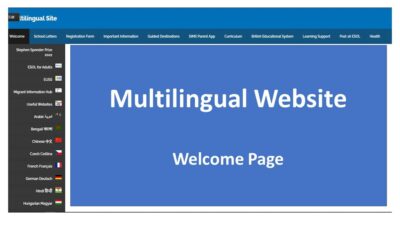 Parental engagement is important for effective support of pupils’ learning and for this reason, schools always look for ways to improve family members’ participation in their children’s education. In this post, EAL Coordinator Anna Czebiolko presents one of the ways that schools and families can work together.
Parental engagement is important for effective support of pupils’ learning and for this reason, schools always look for ways to improve family members’ participation in their children’s education. In this post, EAL Coordinator Anna Czebiolko presents one of the ways that schools and families can work together.
Building a Multilingual Website
Being responsible for the EAL provision in a large secondary school, I was considering different communication strategies between the academy and our families. In 2019, the school worked towards the creation of an internal website for the staff. Building on this previous initiative, the idea of establishing a practical electronic portal for families appeared as a potential new plan. This is how our Multilingual Website project started! Very soon our internal source of information for parents and carers was ready to be accessed through the official school webpage and the initiative was presented to the families in the initial introductory consultations. With time, the website became a useful source of information also for other teaching staff to use when working with non-English speaking families.

The information in the portal was intentionally presented in the format of short, straight-forward messages, acting as reminders. The aim was clear and we focused on making accessible the most important information for families. The Welcome Page featured news such as the timings of the school day, dates of the next holidays or upcoming events. Translations of the school letters were added to a separate tab. I wanted all families to be aware of the current initiatives taking place at the academy and so the top 15 languages for the translations were the most common ones among our pupils. Letters were translated regularly, which helped with systematic upload. Those translations could then be printed off by any member of the staff if needed. Not only letters but other personalised documents as well. The website was gradually filled with visualised mini guidebooks, for instance How to use SIMS Parents app or Home Learning Guides. Illustrated and translated instructions were handy for the receptionists, heads of years and teachers alike.
What would families be interested in? What information may they need?
I thought that adding a separate tab with information regarding the British Education system would be a useful starting point. Under the Post-16 tag, I then gathered notices about English for Speakers of Other Languages (ESOL) courses available at the local colleges in order to support parents with their English language journey. The next tab, called Learning Support, consisted of translated leaflets about bilingual children, online safety and GCSE Support. The latter included links to other useful websites and general pieces of advice. The Multilingual Website showed details about the school uniform and necessary equipment as well as translated templates of progress review reports. There were also registration forms available in a number of different languages. All the material was used by my co-workers and by the EAL department during admission meetings.
The Curriculum section had curricular resources available to read online or to be downloaded. For example, I added a number of translated books in the form of pdfs, such as Macbeth, An Inspector Calls and Animal Farm. For other lessons, we included subject-specific glossaries. The teachers in the Maths Department constructed their own Mathematics EAL Support page. Terminology for Media or for Science was offered as well. The idea behind this specific subpage was simple: we wanted newly arrived pupils to be presented with plenty of resources so they could not only start preparing for the initial lessons but also understand what lesson content they would later need to comprehend.

Another content area that I felt important to add was a record of advice regarding health and pupil well-being. For example, I included advice on using the 111 services with linguistically diverse options, general recommendations about how the NHS works, e.g. making GP appointments, or, as it appeared relevant at the time, suggestions about using lateral flow tests or accessing vaccination centres. The internet site users could also gather more insight into children’s mental health and NHS financial advice. All of this was presented on the website in the form of translations, of course, to the extent of their availability.
Finally, there was no hesitation about broadening the Multilingual Website and displaying several links to useful migration-related organisations, hubs and local events such as New to Leeds, Migrant Information Hub or MESH. This signposting section was also enriched by being organised into particular languages, which were the most common within our parental community. For example, our French speakers could find out about the local meetings for the same language users. Visitors to these portals could be redirected to foreign embassies and consulates, and social groups such as Leeds Language Exchange as well as local complementary/supplementary schools.
In conclusion
The benefits of the Multilingual Website were numerous. Undoubtedly, this initiative could be taken as a positive welcoming message for our newly admitted pupils, their parents and carers. The most important information was presented in a simplified arrangement, which could be acquired by anyone. Also, all the staff members could effectively use the resources to communicate with families. Looking ahead, other sections could be developed. An initial direction could be an interactive forum for families. Ultimately, this time-saving, multidisciplinary and practical tool was used for many purposes. Personally speaking, the process of building up the website was a creative and rewarding exercise for an EAL coordinator. Even though it took time to materialise the idea and create the portal, it was definitely worth the effort!

